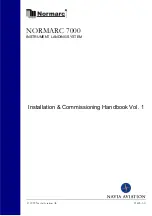
89000046-014
KSN 780/8XX/900 AeroNav AML STC Installation Manual for Helicopters
Rev 0
Page 5-3
© Honeywell International Inc. Do not copy without express permission of Honeywell.
displayed. Note the hottest source(s) on that page and supply that information to BendixKing
Technical Support to include both the source and the associated temperature for follow-on guidance.
The metal bezel of the AeroNav XXX is intentionally designed to radiate heat away from the internal
components and out of the unit. This can have the effect of a bezel that may be warm to the touch.
This is considered normal. Note that the rubber bezel buttons will not conduct this heat and should
not be warm. This condition will be more noticeable on hot days or during long ground runs.
5.7 Electrical Bonding
The electrical bonding between the AeroNav XXX tray and aircraft ground should be
≤
2.5 milliohm.
5.8 Weight and Balance
After installing the AeroNav XXX, the aircraft’s weight and balance must be updated after installation
is complete.
For those installations where an AeroNav 900/800 is replacing a GNS530/430 (any variant), since the
AeroNav 900/800 is within 5% of the weight of the removed GNS530 (less than 1 pound difference),
no new weight and balance must actually be performed according to AC 43.13-1B Change 1
Acceptable Methods, Techniques, and Practices Aircraft Inspection and Repair (Chapter 10) and AC
120-27E Aircraft Weight and Balance Control.
5.9 Compass Safe Distance
The AeroNav XXX should be installed 12” or more away from the aircraft’s magnetic compass.
Perform an aircraft compass swing/calibration after completing the AeroNav XXX installation.
Note: The 12” minimum distance is a TSO-driven value that is designed to ensure the unit will have
no impact on the aircraft compass. If an installation is made where this distance is less than 12”, then
a compass swing/calibration must be accomplished after completing the AeroNav XXX installation.

































